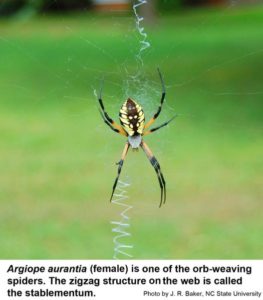Beneficial Arthropod Alert – Orb Weaver Spiders
go.ncsu.edu/readext?732991
en Español / em Português
El inglés es el idioma de control de esta página. En la medida en que haya algún conflicto entre la traducción al inglés y la traducción, el inglés prevalece.
Al hacer clic en el enlace de traducción se activa un servicio de traducción gratuito para convertir la página al español. Al igual que con cualquier traducción por Internet, la conversión no es sensible al contexto y puede que no traduzca el texto en su significado original. NC State Extension no garantiza la exactitud del texto traducido. Por favor, tenga en cuenta que algunas aplicaciones y/o servicios pueden no funcionar como se espera cuando se traducen.
Português
Inglês é o idioma de controle desta página. Na medida que haja algum conflito entre o texto original em Inglês e a tradução, o Inglês prevalece.
Ao clicar no link de tradução, um serviço gratuito de tradução será ativado para converter a página para o Português. Como em qualquer tradução pela internet, a conversão não é sensivel ao contexto e pode não ocorrer a tradução para o significado orginal. O serviço de Extensão da Carolina do Norte (NC State Extension) não garante a exatidão do texto traduzido. Por favor, observe que algumas funções ou serviços podem não funcionar como esperado após a tradução.
English
English is the controlling language of this page. To the extent there is any conflict between the English text and the translation, English controls.
Clicking on the translation link activates a free translation service to convert the page to Spanish. As with any Internet translation, the conversion is not context-sensitive and may not translate the text to its original meaning. NC State Extension does not guarantee the accuracy of the translated text. Please note that some applications and/or services may not function as expected when translated.
Collapse ▲If you see big spiders this fall, they are probably one of our native orb weavers. These could be mistaken for the dreaded invasive joro spider. Do not confuse the two! Orb weavers are very beneficial to humans, capturing moths that might otherwise produce caterpillars which can be pests in our fall gardens.
The black and yellow orb weaver is a showy spider usually noticed in late summer. The bodies of females grow to a little more than one inch long; males are much smaller. The third pair of legs is about half as long as the other legs. The segment to which the legs and mouthparts attach is covered with very short, shiny, white scales. The abdomen is egg-shaped and conspicuously marked with black and yellow.
Females spin orb webs (spiral sticky threads suspended on non-sticky spokes) with a conspicuous white zigzag structure in the middle called the stablementum. Spider experts disagree about why these spiders spin stablementa. Earlier the stablementum was thought to give stability to the web. Now the thinking is that the stablementum attracts insects or keeps birds from flying through the web.
All spiders are carnivores that prey primarily on insects. Black and yellow garden spiders find their prey by sensing vibrations in the web. They eat anything that doesn’t tear itself loose from the web. At night, females consume the sticky strands of the web and spin new ones. It is thought they gain some nutrition from minute insects and even miscellaneous organic matter caught in the web.
Black and yellow garden spiders are not aggressive toward humans. It might be possible to induce one of these spiders to bite, but the spider would probably have to be handled carelessly for that to happen. Because black and yellow garden spiders are considered to be beneficial arthropods home gardeners are advised to leave the spiders alone.
Parts of this article excerpted from NC State University Black and Yellow Garden Spider PDIC Factsheet
Author
James Baker
Professor Emeritus
Entomology and Plant Pathology





